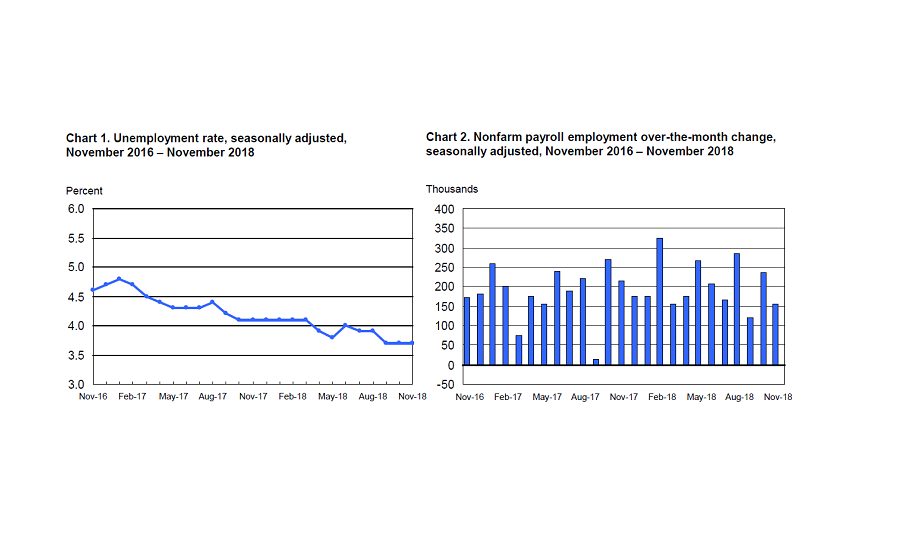National nonfarm employment increased by 155,000 in November, and the unemployment rate remained unchanged at 3.7%, according to the new report from the U.S. Bureau of Labor Statistics. Job gains occurred in manufacturing, health care, transportation and warehousing.
The manufacturing industry added 27,000 jobs in November, with increases in chemicals (6,000 jobs) and primary metals (3,000 jobs). Manufacturing employment has increased by 288,000 over the year, largely in durable goods industries, according to the report.
“With 27,000 new jobs in November, manufacturing continues to build on its strong growth over the past two years," said Dr. Chad Moutray, chief economist, National Association of Manufacturers. "Game-changing tax and regulatory reform has led to manufacturers hiring more workers and raising wages and benefits. Nonetheless, with nearly half a million open jobs in manufacturing today, and 2.4 million manufacturing jobs expected to go unfilled over the next decade, our industry faces an unprecedented workforce crisis. We will continue to work with Congress and the administration to keep this momentum going and build the modern manufacturing workforce we so desperately need.”
November's total job gains compared to an average monthly gain of 209,000 jobs over the last 12 months.
In November, the unemployment rate was 3.7% for the third month in a row, and the number of unemployed persons stood at 6 million. Over the year, the unemployment rate and the number of unemployed persons declined by 0.4 percentage point and 641,000, respectively.
"The unemployment rate of 3.7% in November marked the first time since 1969 that the unemployment rate has not exceeded 3.7% for three straight months," said U.S. Secretary of Labor Alexander Acosta in a press release. "For an astonishing seven months this year, the unemployment rate has been below 4%. Last month matched a record low, set earlier this year, for the African-American unemployment rate."
Among the major worker groups, the unemployment rates for adult men (3.3%), adult women (3.4%), teenagers (12%), whites (3.4%), blacks (5.9%), Asians (2.7%), and Hispanics (4.5%) showed little or no change in November.
The number of long-term unemployed (those jobless for 27 weeks or more) declined by 120,000 to 1.3 million in November. These individuals accounted for 20.8% of the unemployed.
Both the labor force participation rate, at 62.9%, and the employment-population ratio, at 60.6%, were unchanged in November.
The number of people employed part-time for economic reasons (sometimes referred to as involuntary part-time workers), at 4.8 million, changed little in November. These individuals, who would have preferred full-time employment, were working part time because their hours had been reduced or they were unable to find full-time jobs.
Health care employment rose by 32,000 in November. Within the industry, job gains occurred in ambulatory health care services 19,000 jobs) and hospitals (13,000 jobs). Over the year, health care has added 328,000 jobs.
Employment in transportation and warehousing rose by 25,000 in November. Job gains occurred in couriers and messengers (10,000 jobs) and in warehousing and storage (6,000 jobs). Over the year, transportation and warehousing has added 192,000 jobs.
In November, employment in professional and business services also continued on an upward trend, adding 32,000 jobs. The industry has added 561,000 jobs over the year.
Retail trade employment changed little in November (18,000 jobs). Job growth occurred in general merchandise stores (39,000 jobs) and miscellaneous store retailers (10,000 jobs). These gains were offset, in part, by declines in clothing and clothing accessories stores (a drop of 14,000 jobs); electronics and appliance stores ( drop of 11,000 jobs); and sporting goods, hobby, and book stores (drop of 11,000 jobs).
In November, average hourly earnings for all employees on private nonfarm payrolls rose by 6 cents to $27.35. Over the year, average hourly earnings have increased by 81 cents, or 3.1 percent. Average hourly earnings of private-sector production and nonsupervisory employees increased by 7 cents to $22.95 in November.

